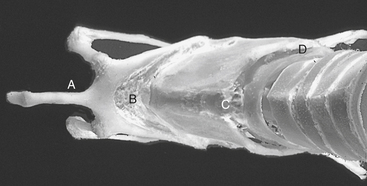CHAPTER 52 Ultrasonographic Examination of the Upper Airway
Clinical evaluation of the upper airway of horses with the presenting complaint of poor performance or abnormal upper respiratory noise is typically initiated with a thorough physical examination to localize the problem. This includes assessment for enlargement or obstruction of the nasal passages or other evidence of sinonasal disease, including nasal discharge and physical deformation, and palpation for evidence of acquired or congenital diseases. Acquired diseases include tracheal deformation, neurogenic atrophy of the dorsal cricoarytenoideus muscle, and thrombophlebitis, whereas congenital disease is exemplified by fourth branchial arch defect. Physical examination may be normal or, in many instances, might not fully characterize the problem, necessitating further diagnostic tests.
EQUIPMENT AND PREPARATION
It is preferable to examine the horse while restrained in stocks and wearing a standard halter, so that the handler can limit its head movements. The examination is performed with the horse unsedated to allow accurate evaluation of arytenoid cartilage and vocal-fold movement and of the laryngohyoid position. Hair clipping is generally not required except for heavily coated draft breeds. Alcohol is the preferred acoustic coupling agent; however, acoustic coupling gel may be used instead. In some instances, skin-associated artifacts that reduce image quality and can impede image interpretation have been encountered. These seem to occur when the examination takes longer and the alcohol begins to dry on the hair (alcohol drying effect) or the horses undergo strenuous exercise before ultrasound. The sweat generated during exercise or the cold hosing following treadmill testing may be responsible for reducing image quality.
ULTRASOUND TECHNIQUE
As with any ultrasound examination, it is important to evaluate the larynx in a systematic manner. This is facilitated by a standardized examination that uses specified imaging locations termed acoustic windows. This is particularly important in the laryngeal region because gas, bone, and mineralized cartilage all create acoustic shadows that prevent imaging. The use of standard acoustic windows allows the ultrasonographer to avoid bone and gas impedance, develop familiarity with the normal appearance at each site, clearly communicate abnormal findings by location, and ensure that all relevant structures are imaged each time. It is recommended that the ultrasonographer proceed sequentially through the five acoustic windows described and label any stored images appropriately (Figure 52-1). Beginning on the ventral aspect of the throat and proceeding from rostral to caudal, the following acoustic windows are evaluated: rostroventral (rostral to the basihyoid bone), midventral (region between the basihyoid bone and thyroid cartilage), and caudoventral (imaged through the cricothyroid membrane and extending caudally to the first few tracheal rings). On completing the examination through the ventral windows, imaging proceeds with the right and left caudolateral windows just caudal to the angle of the mandible at the lateral aspect of the larynx on each side.




